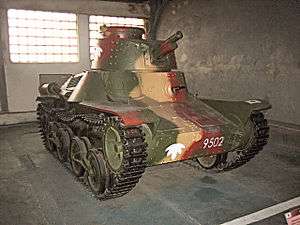Type 4 Ke-Nu
| Type 4 Ke-Nu | |
|---|---|
|
Type 4 Ke-Nu light tank | |
| Type | Light tank |
| Place of origin |
|
| Production history | |
| Designed | 1944 |
| Produced | 1944 |
| Number built | approx. 100 |
| Specifications | |
| Weight | 8.4 tons |
| Length | 4.30 meters |
| Width | 2.0 meters |
| Height | 2.0 meters |
| Crew | 3 |
|
| |
| Armor | 6–25 mm |
Main armament | Type 90 57 mm |
Secondary armament | 2x Type 97 7.7 mm machine guns |
| Engine |
Mitsubishi A6120VDe air-cooled inline 6-cylinder diesel 120 HP |
| Power/weight | - |
| Suspension | bell crank |
Operational range | 240 km |
| Speed | 40 km/h |
The Type 4 Ke-Nu (四式軽戦車 ケヌ Yon-shiki keisensha Kenu) was a light tank of the Imperial Japanese Army in World War II. It was a conversion of existing Type 95 Ha-Go light tanks, re-fitted with the larger turret of the Type 97 Chi-Ha medium tank.[1]
History and development
The Type 4 Ke-Nu was a variant of the Type 95 Ha-Go light tank.[1] The original Type 97 Chi-Ha medium tank had been armed with a low muzzle velocity 57 mm tank gun. Operational experience against the Soviet Union at Nomonhan during the brief Japanese-Soviet Border War in 1939 revealed that this gun was inadequate against opposing armor, and a new higher velocity 47 mm tank gun was developed. This was installed in the Type 97 Chi-Ha with a larger turret to produce the Type 97-kai Shinhoto version.[2] This left a large number of surplus Type 97 Chi-Ha turrets, which were later retrofitted onto the hulls of the obsolete Type 95 Ha-Go light tank. The result was designated the Type 4 Ke-Nu.[3] In total, approximately 100 units were converted in 1944.[4]
Design
Essentially a Type 95 light tank with a Type 97 medium tank gun turret, the Type 4 Ke-Nu had slightly better firepower, but at the expense of an additional ton in weight. This reduced the top speed of the tank to 40 km/h, but did nothing to alleviate the greatest weakness of the Type 95, its lack of suitable armor protection for the hull. Maximum armor protection for the tank (25 mm) was provided by the Type 97 turret, and it was defeated by the 37 mm, 75 mm and 2-pounders mounted on Allied tanks.
Combat record

The conversion coming in 1944 was too late to make any impact on Japanese combat operations, and most of the Type 4 Ke-Nu were retained in the Japanese home islands against the projected American invasion. Some were assigned to units in Korea and Manchukuo, and saw brief combat against Soviet forces in the Soviet invasion of Manchuria.[5] A surviving Type 4 Ke-Nu captured in Manchukuo is on display in Moscow at the Kubinka Tank Museum.
Notes
- 1 2 Zaloga 2007, p. 18.
- ↑ Zaloga 2007, pp. 12, 13, 14.
- ↑ Zaloga 2007, pp. 14, 18.
- ↑ History of War: Type 4 Ke-Nu Light Tank
- ↑ History of War: Type 4 Ke-Nu Light Tank.
References
- Zaloga, Steven J. (2007). Japanese Tanks 1939–45. Osprey. ISBN 978-1-8460-3091-8.